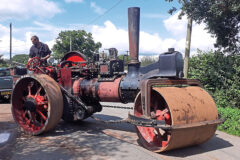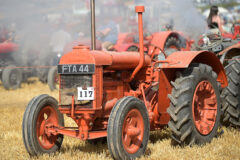Introducing Ford’s FW Series of 1970s giant tractors
Posted by Chris Graham on 17th November 2023
Jonathan Whitlam explains the development and specifications of Ford’s FW Series range of articulated, four-wheel-drive tractor giants.

The Ford Motor Company needed a presence in the large, articulated, 4WD tractor market to compete with the likes of John Deere and IH. With the huge costs inherent in trying to design and build such a range of machines in-house, the company opted to buy-in the technology and the result had an impact right across the agricultural world.
The Ford Motor Company played a very important role in farm mechanisation in North America. Its Fordson Model F produced for the American market from 1918 was instrumental in bringing tractor power to the smaller farmers of the USA, and took over the market right into the 1920s, by which time it had become somewhat dated and was eventually dropped, the tooling being sent over to Cork, in Ireland. Tractors such as the International Harvester Farmall took over as a much more versatile proposition, along with lots of other similar products being produced by many different manufacturers.
It was only after Harry Ferguson approached Henry Ford in the late 1930s, with his idea to produce a tractor using his Ferguson System of hydraulic draft control and three-point linkage, that Ford once again entered the North American tractor market with a home-produced product. The resultant Ford 9N was introduced in 1939 and its compact, sleek and modern design was very different to any other tractor then being produced, as was the incorporation of the Ferguson System. This allowed this small tractor to do much heavier work thanks to the special implements used, which became an integral part of the machine itself.
The Ford 9N was a huge hit and sold extremely well once farmers began to realise the benefits that it offered, and many replaced older, more basic, machines produced by the other North American tractor manufacturers – Ford was back!

The Steiger Panther ST360 was the type of Series III Steiger machine that formed the basis for the Ford FW Series. Built in Fargo, North Dakota, it was powered by a Cummins six-cylinder engine. For its badge-engineered version, Ford stipulated a Cummins V8. In the end, though, North American farmers preferred the green Steiger.
Sixties expansion
The 9N went on to be the progenitor of a whole range of Ford tractors in the USA, which were expanded and developed right up to 1964, when a brand-new range arrived. This was a worldwide type produced in both Basildon and Antwerp as well as at the Highland Park factory in America. The new range consisted of four models with three- and four-cylinder engines with the largest being the 65hp 5000, although one of the earlier American Ford models was retained in the shape of the 6000. This was a larger, 85hp, six-cylinder tractor, and was the biggest and most powerful that Ford had produced up to that point.
As other manufacturers introduced more powerful machines, Ford struggled a bit to keep up, although it did take a significant step forward when the 6000 was replaced by the all-new 8000 model, featuring a brand-new Ford six-cylinder power unit. This engine also proved to be much more reliable than the previous range-topper and was also more powerful as well, with a rated output of 115hp. Then, a year later, this tractor was strengthened and fitted with a turbocharger to create the mighty 9000; a 145hp beast of a machine!
These two flagship machines were very successful at retaining Ford’s presence at the larger end of the market, and provided genuine alternatives to the competition from IH and John Deere. Big, two-wheel-drive tractors were a mainstay of farming in North America during the 1970s, although they weren’t the largest machines on the prairies, as we shall see.
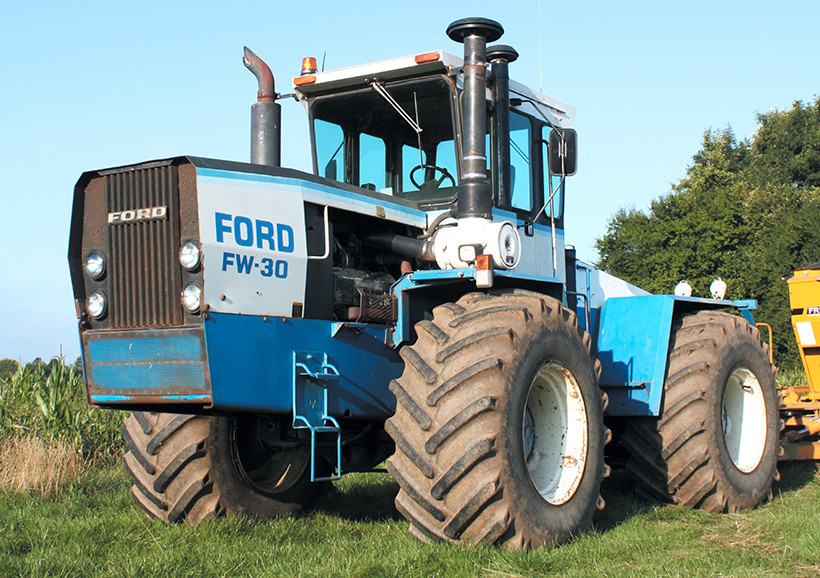
This FW-30 isn’t what it seems. It’s the later, European version that I’ll be looking at more closely next time. It differs substantially from the 265hp, North American version.
The 8000 and 9000 evolved during the 1970s, first into the 8600 and 9600 then, in 1976, into the more refined 8700 and 9700, with the latter boasting 153hp on tap. The 9700 was an impressive machine and a fitting flagship for the entire Ford tractor range. In Europe the 8700 and 9700 were among the first to be offered with a factory-fitted four-wheel-drive option but, in North America, things were very different – four-wheel-drive was reserved for something altogether larger!
Articulated power
The farmers working the huge fields in North America demanded larger and more powerful tractors that could be used to pull ever-wider tillage implements. But with major manufacturers like Ford not catering for such needs, it was left to various pioneers to take up the slack. Key among these were the Wagner brothers, who began experimenting with adapted truck components to produce a pivot-steer monster tractor for their own use. The result was so successful that, in the 1950s, they established a tractor-building company – Wagner Tractors Inc. of Portland, Oregon – to produce a range of these enormous machines, and the era of the articulated tractor had arrived.
Another farming family that needed something bigger was the Steigers, from Red Lake Falls in Minnesota. Brothers Doug and Maurice produced their first articulated tractor in 1957, once again for their own use, but their neighbours were so impressed that they all wanted one too, which is how the Steiger tractor manufacturing business began. The lime green-painted Steiger tractors soon garnered a reputation for ruggedness and reliability, and production grew significantly when the company moved to a purpose-built factory in Fargo, North Dakota, in 1969.
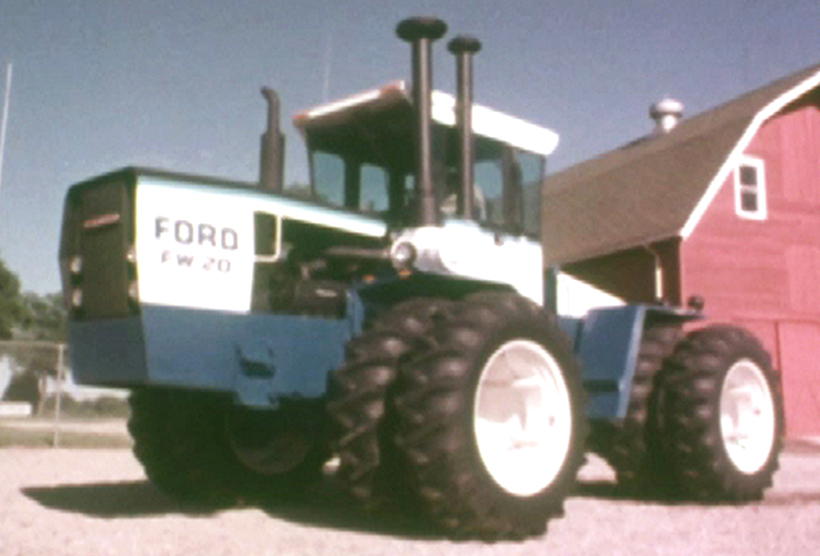
The entry-level FW Series model was the 210hp FW-20; the only one to use a Cummins V-555 V8 engine. The three larger models all relied on the V-903 V8 powerplant.
The success of producers like Wagner and Steiger, plus others such as Versatile over the border in Canada, didn’t escape the notice of the ‘big boys’. John Deere entered an agreement with Wagner to produce a series of Wagner tractors in John Deere colours to top out its range of standard models. Such was the success of this move that John Deere soon put its own designs into production, leaving Wagner high and dry. What’s more, the inevitable split between the two companies left Wagner tied up in legal restrictions that prevented it from returning to tractor manufacturing.
International Harvester entered an agreement with Steiger to produce a joint product, based on Steiger technology and built in Fargo, to top-out its own range of tractors and, in 1977, Ford also turned to Steiger for a similar arrangement.
The FW is born!
However, the Ford Motor Company was obviously keen to keep up with the competition by offering its own large, articulated, four-wheel-drive tractor range to push sales on further up the power scale and, in 1977, the company announced the brand new, four-model FW Series. Unlike IH, Ford basically went to Steiger and asked it to produce badge-engineered versions of its own articulated tractors, but painted in Ford colours. So there were no Ford components used in those ‘Ford’ tractors!
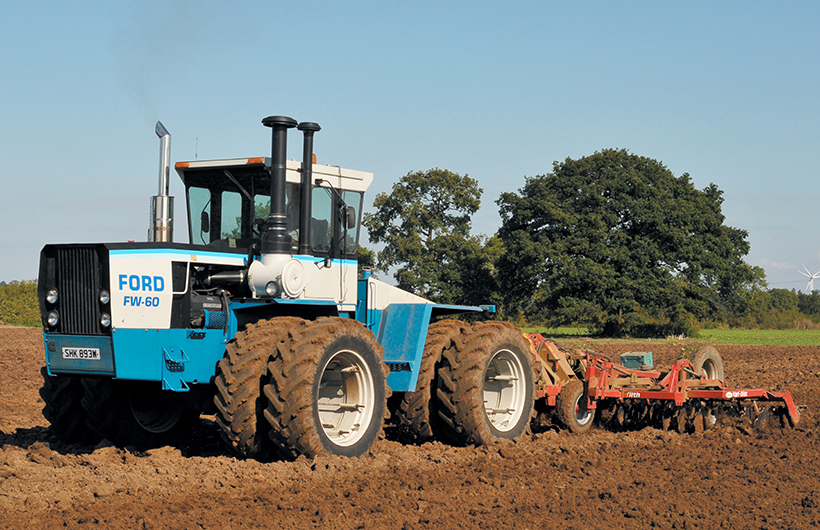
The range-topping FW-60 was an impressive beast, with 335hp on tap from its turbocharged V8 Cummins engine. This example was one of the first to be exported to the UK, and was the machine used in the publicity material for the UK launch.
Based on the Series III Panther wide-frame Steiger models, the new FW-20, FW-30, FW-40 and FW-60 took the Ford brand into fresh marketing territory, enabling it to compete with the likes of John Deere. To make the new models stand out even more, a revised blue and white livery was adopted, featuring a blue chassis, white tinwork and a black-painted bonnet to prevent glare. The cab was typical Steiger, with two doors and all the main controls falling easily to hand. Power came from Cummins V8 engines.
Despite the fact the new models were based on the Panther, there were several major differences as well as the colour. For starters, the Steiger range used Cummins six-cylinder engines while the Ford-badged machines relied on eight-cylinder engines, albeit from the same manufacturer.
Ford, of course, publicised the new models heavily as a Ford product, with an emphasis on increased work rate that was achievable over a two-wheel-drive tractor, thanks to the enhanced size and power. The entry-level model – the FW-20 – was rated at 210hp which seems comparatively small by today’s standards, but it was an impressive output back in 1977, especially when you remember that the biggest Ford tractor previously had been the 153hp 9700!
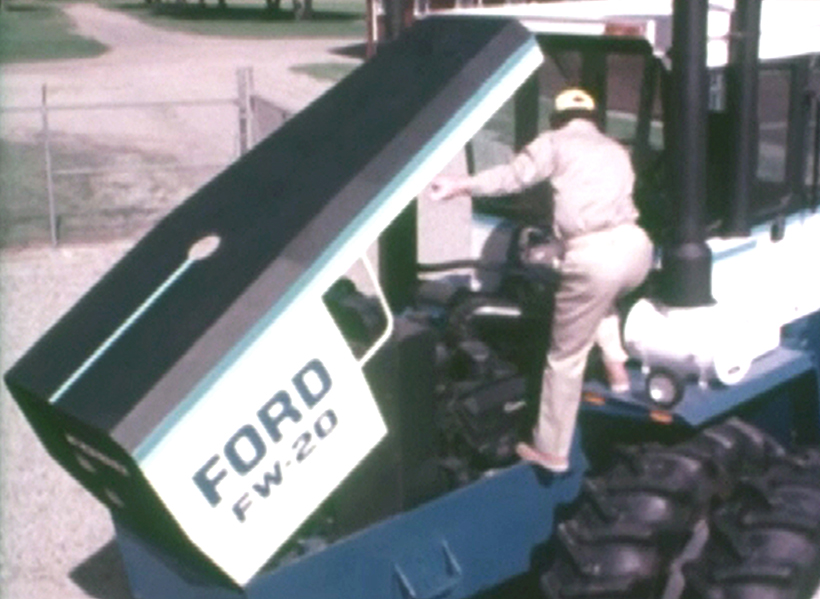
The top of the FW’s bonnet was painted black to reduce glare from the sun affecting the driver. The whole, massive bonnet could be hinged forwards to gain access to the engine for routine maintenance.
The FW-30 came next with more power, being rated at 265hp, and it was closely followed by the 295hp FW-40, taking this model very close to 300hp mark. However, that ‘barrier’ was broken by the flagship model – the FW-60 – which produced an earth-shattering 335hp, thanks to a turbocharger. The Cummins engines used were the V-903 for the top three models, and the V-555 for the FW-20, and all were eight-cylinder units delivering plenty of torque which made them ideal for draft work.
The power was transmitted through a Spicer gearbox offering 10 forward and two reverse gears as standard, but an optional 20×4 speed version was also offered. Heavy-duty front and rear axles of a double-reduction type were designed for ruggedness and reliability, and were built by Raba in Hungary, while an optional no-spin differential was available for either just the front axle, or both axles, which helped reduce wheelspin under heavy load.
Self-adjusting multiple disc brakes were fitted to give a quick stopping ability for these large, heavy machines, making them safer to operate. A range of single or dual wheels was offered for the range, with most American farmers opting for dual wheels all-round to maximise traction and spread the weight of the machine over the widest area so they ‘trod lightly’ for crop establishment work.
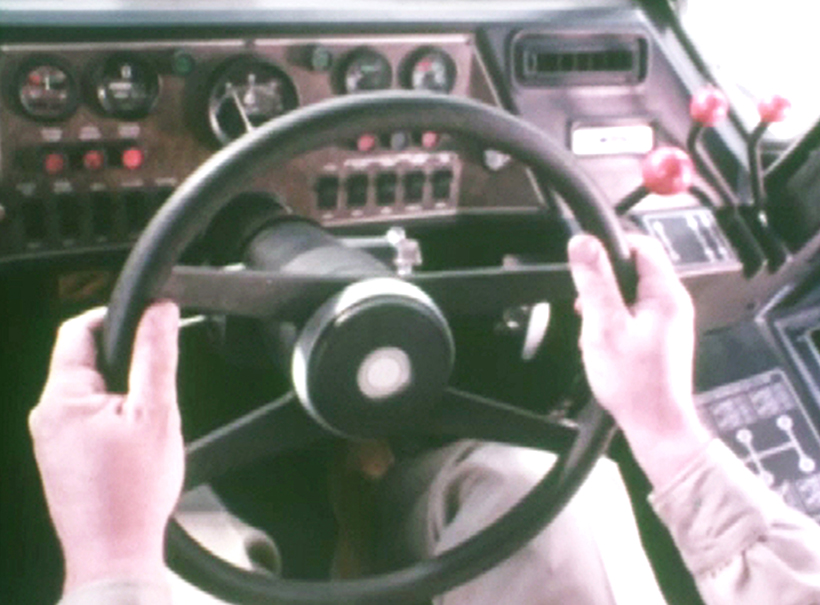
The steering wheel is fully adjustable, both in terms of tilt and height, giving car-like driving ergonomics. The instrumentation is uncluttered and easy to read.
The cab was designed to be a comfortable place, enabling long days to be tackled, and the design featured plenty of tinted glass to ensure good, all-round visibility. It also featured wide doors, and the whole cab was mounted on rubber isolators to reduce noise transference and vibration. To allow access to and from the door on the right-hand side of the driving seat, the hydraulic control console was designed on a hinge, and could be lifted out of the way easily. The steering wheel could tilt and telescope so that the operator could find the best position to drive comfortably, while the Bostrom seat was also fully adjustable. Air conditioning and a cab heater both came as standard to minimise pollen and dust entry, while a radio cassette player was also part of the standard specification.
Plenty of hydraulic options were available, with extra spool valves and, unusually for a big, American tractor, a three-point linkage as well as a hydrostatically-operated power take-off and heavy-duty drawbar. The latter was attached to the tractor’s front frame section rather than to the rear, thereby making the front wheels pull instead of begin pushed when heavy draft loads were placed on it, and helping to keep the nose of the tractor down.
All these specifications were proudly detailed in the Ford promotional material that accompanied the range launch, in which the new models were described as ‘The Big Ones from Ford’. As the company’s first entry into the articulated 4WD market, the FW Series machines were certainly impressive, and their obvious Steiger parentage was seen as a bonus by Ford, even though they were competing directly against Steiger’s own machines.
FW in the USA
One of the main benefits of adding these badge-engineered giants to the Ford tractor range was that it gave dedicated Ford dealers all over North America a range of high horsepower 4WD machines to sell. This development also came at a time when the Ford Motor Company was very keen to become a ‘full-liner’, selling not only tractors but also a wide range of different farm machinery to go with them; everything from ploughs to combine harvesters.
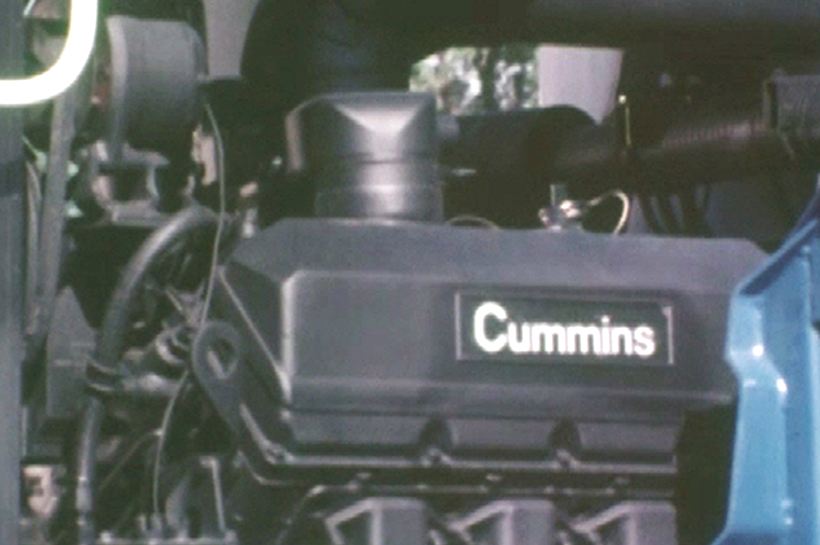
Many truck components were used on the FW tractors, as had become the norm for big, articulated, 4WD tractors in North America. These included Spicer transmissions and Cummins V8 engines. This FW-20 is powered by a V-555 9.1-litre motor.
To achieve this it had entered into an array of agreements with different firms, including the German Claas company, that was supplying combines and balers in Ford livery. So the badge-engineered Steiger tractors were just an extension of this policy, and an attempt to equip Ford dealers with as much machinery to sell as, say, a John Deere or IH distributer.
In the end, though, the FW range didn’t prove as popular in the US as had been expected. It seems that most farmers were aware of the Steiger brand, held it in high regard, but would rather buy a proper green one rather than a Ford-badged version. However, the project was saved thanks to an unlikely discovery. After tentatively testing the European sales market, Ford quickly realised that the FW Series could fill a niche market on this side of the Atlantic and, ultimately, sales in Britain and, to a lesser extent, the rest of Europe, proved sufficient to save the FW range from an early demise.
Not all versions made the transition though and, in the end, just two revised models were put on sale on this side of the pond. Next time I’ll be taking a close look at the first of those, the FW-30.
This feature comes from the latest issue of Ford & Fordson Tractors, and you can get a money-saving subscription to this magazine simply by clicking HERE



